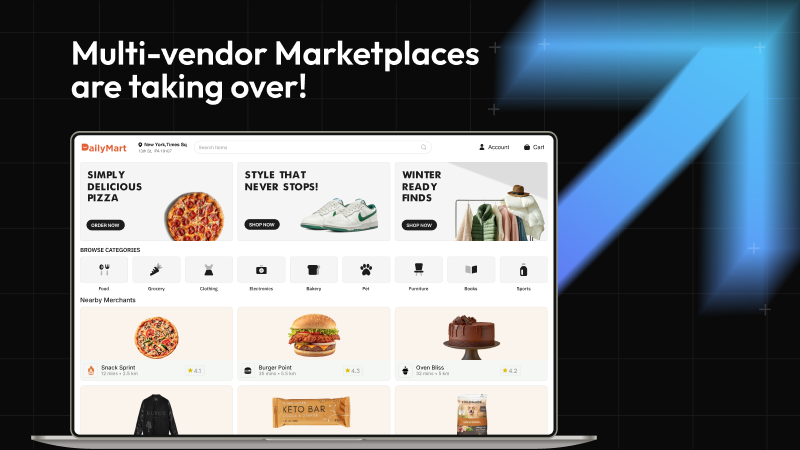.avif)
Table of Contents
Introduction
The food delivery industry has undergone a profound transformation in the last decade. Whether it’s a rainy evening, a busy workday, or a casual Friday night, food delivery apps have emerged as the most convenient option. Uber Eats, DoorDash, and countless other apps have disrupted traditional food ordering. And now, customers’ expectations have changed, and so have business opportunities.
Chances are, most of you reading this are either restaurant owners, local delivery startups, cloud kitchen operators, food enthusiasts, or small ecommerce food brands, and are wondering whether food delivery apps can be profitable. And it’s probably because:
1. You feel stuck, giving away 15 to 30% of every order to someone else’s platform.
2. You hate that you don’t own your customer data or brand experience.
3. You want to grow, but don’t know how to build tech.
4. Or wondering whether a food delivery software solution is the right move.
In short, yes, food delivery apps are indeed profitable, but only when done the right way. Let’s see how the food delivery infrastructure works and what myths are holding businesses back from real growth.
What Drives Profitability in Food Delivery Apps?
1. Lower commission means higher profit
One of the biggest drawbacks of relying on third-party platforms is they snatch 20 to 30% of your earnings on every order, and for a small or medium-sized restaurant, losing this significant chunk of profit makes it harder to reinvest in quality, staff, or growth.
But having your food delivery app not only keeps you safe from paying those commissions, but also-
1. Makes you more profit per order.
2. You get full access to customer data.
3. You build real customer relationships.
4. Protects you from competing side-by-side with 50 other restaurants in a crowded app.
In short, having a food delivery app is a wise choice, and the benefits are more than you can count on your fingers.
2. Brand control and customer loyalty
Owning a food delivery app gives the ability to control certain operations and modify them according to need. It allows you to design your app's look, offer special deals to loyal customers, and stay in touch with them directly. This creates a strong brand image and trust, ultimately leading to higher sales for businesses.
3. Direct upselling and cross-selling
One silent downside of using third-party platforms is that they usually promote items that help them earn more. But owning the app puts you in the driver’s seat and gives you control over what the customer sees, which gives you access to offer deals that increase your profit and be in charge of what to promote and when to promote.
The Real Obstacles to Profitable Food Delivery
Despite being a high-demand industry, valued at $288.8 billion in 2024 and projected to reach $505.5 billion by 2030, many food delivery apps are still not profitable or have only recently started profiting after years of heavy losses. In fact, major players like DoorDash, Deliveroo, and Just Eat Takeaway have collectively racked up over $20 billion in operating losses even while growing rapidly.
A few reasons out of many could be:
1. Fierce competition from many players, as they all compete to capture market share, which forces them to offer constant discounts that eventually reduce profit margins.
2. User loyalty is usually thin, as they often switch apps to capture the best deals. And to retain these users, regular discounts and promotions become essential.
3. Failed deliveries and refunds deliver a direct attack on profits. Orders that go wrong (late, cold, or missing items) often result in refunds. Neglecting it may harm trust and customer sentiments, and tarnish the app's image.
4. Inflation, higher fuel prices, and riders demanding better wages shrink overall margins, which can deteriorate operations, especially if the app isn’t charging enough to cover the rising costs.
That’s why companies like Uber Eats have pulled out of some markets, despite being a global brand, because maintaining profitability was no longer practical in certain areas.
Common Myths About Delivery Apps
Myth 1: Only Big Chains Can Afford a Delivery App
It used to be true that only big chains could afford a delivery app, but not anymore. Today, even small restaurants or solo food business owners can create their own delivery app without hiring any developers. With modern food delivery app makers, you just have to choose the features, add your branding, and you’re good to go. They are ready to use and easy to customize, which makes the process affordable and convenient.
Myth 2: Delivery Apps Are Too Expensive to Maintain
There's a common belief that building your delivery app costs a fortune, which is true only if you build the entire app from scratch. But now you can use a good food delivery app builder that provides ready-made tools, regular updates, tech support, and built-in features with a fixed, manageable monthly fee.
Myth 3: It's Hard to Compete With Big Aggregators
Many restaurant owners drop the idea of building their app, thinking they can’t stand a chance against the big names. But that’s not always true.
Because it’s the instinct of people to support their neighborhood restaurant, but for that, they at least demand smooth and reliable service. Popular apps often treat every restaurant the same. But if you give customers a more personal experience, like offering discounts and special deals, you can create long-lasting relationships with them– something these big aggregator apps can’t easily do.
Conclusion
In short, a food delivery app is profitable, but only when it’s built and managed the right way. However, profitability doesn't come easily.
Challenges like high competition, thin customer loyalty, rising delivery costs, and refunds can affect your margins, but instead of giving a high commission to third-party platforms and losing control over your customers, having a food delivery app is a sensible choice.













